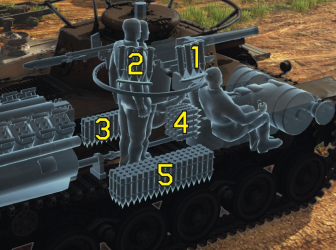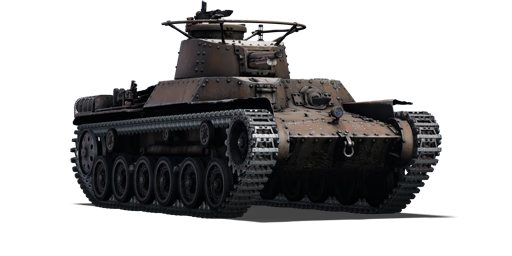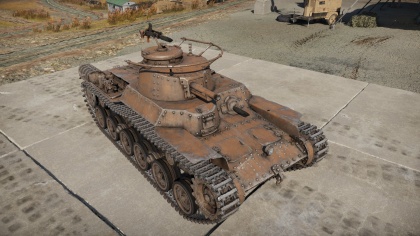Chi-Ha
Contents
| This page is about the Japanese medium tank Chi-Ha. For other uses, see Chi-Ha (Family). |
Description
The Type 97 Chi-Ha is a rank I Japanese medium tank
with a battle rating of 1.3 (AB/RB/SB). It was introduced in Update 1.65 "Way of the Samurai" along with the initial Japanese vehicles of the Japanese Ground Forces Tree.
The Chi-Ha is more or less a smaller version of the I-Go but with a better engine, the Chi-Ha seems rather mediocre at first glance. However, this tank can perform quite well at its battle rating provided that it is played to its strengths, those being its decent mobility and cannon.
General info
The Type 97 Chi-Ha is an upgraded version of the earlier Type 89 I-Go. The engine has been upgraded, from the Mitsubishi A6120VD air-cooled straight-six diesel with 120 hp to a Mitshubishi SA12200VD air-cooled V12 diesel with 170 hp. As such, the top speed has increased from 27 kph on the I-Go to 38 kph on the Chi-Ha. The armament stays the same, with the same shells and gun characteristics. The 5.7 cm Tank Gun Type 97 is robust, but will get the job done. It still has four crewmen inside, no armour, and a 7.7 mm Type 97 in the hull. Overall, it's in general a better I-Go.
Survivability and armour
Armour: Light, but effective against weaker guns (i.e. early French), weaker shells (low-caliber HE), and in long range engagements.
Armour type:
- Rolled homogeneous armour
| Armour | Front | Sides | Rear | Roof |
|---|---|---|---|---|
| Hull | 25 mm (12-32°) Front plate 17 mm (63-81°) Front glacis 15 mm (37-59°) Lower glacis |
25 mm (40°) Top Left 25 mm (25-27°) Top Right 20 mm Bottom |
20 mm (4-58°) | 12 mm |
| Turret | 25 mm (9-41°) Turret front 25 mm Gun mantlet |
25 mm (10-11°) | 25 mm (12°) | 10 mm |
| Armour | Sides | Roof | ||
| Cupola | 17 mm | 6 mm |
Mobility
| Game Mode | Max Speed (km/h) | Weight (tons) | Engine power (horsepower) | Power-to-weight ratio (hp/ton) | |||
|---|---|---|---|---|---|---|---|
| Forward | Reverse | Stock | Upgraded | Stock | Upgraded | ||
| Arcade | 45 | 21 | 14.8 | 263 | 324 | 17.77 | 21.89 |
| Realistic | 40 | 19 | 150 | 170 | 10.14 | 11.49 | |
Armaments
Main armament
The gun is the same as on the I-Go. Not much to write home about, but we're hardly complaining, especially with the HEAT shell.
| 57 mm Type 97 | |||||
|---|---|---|---|---|---|
| Capacity | Vertical guidance |
Horizontal guidance |
Stabilizer | ||
| 120 | -15°/+20° | ±180° | Vertical | ||
| Turret rotation speed (°/s) | |||||
| Mode | Stock | Upgraded | Prior + Full crew | Prior + Expert qualif. | Prior + Ace qualif. |
| Arcade | 14.47 | 20.03 | 24.41 | 26.9 | 28.61 |
| Realistic | 9.04 | 10.64 | 12.90 | 14.3 | 15.20 |
| Reloading rate (seconds) | |||||
| Stock | Prior + Full crew | Prior + Expert qualif. | Prior + Ace qualif. | ||
| 4.09 | 3.80 | 3.5 | 3.30 | ||
Ammunition
| Penetration statistics | |||||||
|---|---|---|---|---|---|---|---|
| Ammunition | Type of warhead |
Penetration in mm @ 0° Angle of Attack | |||||
| 10m | 100m | 500m | 1000m | 1500m | 2000m | ||
| Type 92 APHE | APHE | 21 | 20 | 17 | 14 | 12 | 10 |
| Type 3 HEAT | HEAT | 55 | 55 | 55 | 55 | 55 | 55 |
| Shell details | ||||||||||
|---|---|---|---|---|---|---|---|---|---|---|
| Ammunition | Type of warhead |
Velocity in m/s |
Projectile Mass in kg |
Fuse delay
in m: |
Fuse sensitivity
in mm: |
Explosive Mass in g (TNT equivalent): |
Normalization At 30° from horizontal: |
Ricochet: | ||
| 0% | 50% | 100% | ||||||||
| Type 90 APHE | APHE | 349 | 2.6 | 1.2 | 15 | 103 | -1° | 43° | 30° | 25° |
| Type 3 HEAT | HEAT | 380 | 1.8 | N/A | 0.1 | 303.36 | +0° | 28° | 21° | 17° |
Ammo racks

| Full ammo |
1st rack empty |
2nd rack empty |
3rd rack empty |
4th rack empty |
5th rack empty |
Recommendations | Visual discrepancy |
|---|---|---|---|---|---|---|---|
| 120 | 117 (+3) | 113 (+7) | 89 (+31) | 69 (+51) | 1 (+129) | No |
Right side only: 69 (+51)
Machine guns
| 7.7 mm Type 97 | ||||||
|---|---|---|---|---|---|---|
| Hull mount | ||||||
| Capacity (Belt capacity) | Fire rate (shots/minute) |
Vertical guidance |
Horizontal guidance | |||
| 3,000 (20) | 499 | ±10° | ±15° | |||
Usage in the battles
The Chi-Ha is the most interesting tank to play in Rank I Japanese tanks as it has little to no armour, a shot-put like a muzzle velocity and looks like a bus in some sense as to how long it is. But there is a way to play this tank despite all the negatives to this tank and to play it to the best of its abilities, one can play it as a support tank in every way (apart from long distance as the rounds drop like a brick after 500m). Stay close to teammates and always play sneaky as the Chi-Ha can be easily one-shotted by everything like all Japanese tanks in this Rank.
But if facing a heavy tank or medium tank of early Rank 2 are very hard to verse from head-on and the fact that the 57 mm APHE rounds lack penetration to destroy it from the front. So the best option is to go up behind it or attack from the side to destroy them. Another problem that shows itself strongly in close quarter fights is that the Chi-Ha has a hand-cranked turret and turning the tank is painful at best. So it is best to plan ahead before attacking, think where the enemy may be and find a place to hide the bulky tank from the enemy and wait for the enemy to come to the firing range. The Type 3 HEAT shell changes this. With 55mm of penetration, the tank is capable of penetrating tanks that it previously couldn't - which is most tanks at rank I and II. In addition to this, the Type 3 HEAT has the potential to hull break lightly armored targets like LVTs or the Sturmpanzer. Use the protection analysis feature to figure out which tanks you can and can't get through, and adapt your playstyle accordingly when those vehicles are encountered. Now, this is somewhat important "Don't look for the enemy, let the enemy look for the Chi-Ha." Of course, the Chi-Ha could still go look for the enemy, but always be on alert and make sure to have a friend for firing support.
Engine power is not that powerful, which then means that the acceleration will be slow to start up, but it will slowly get faster over time. But reversing is like all British tanks when they reverse, It's going to be slow. But this is compensated for the turning speed of this tank as it is better to turn and run in some cases then reverse.
Modules
| Tier | Mobility | Protection | Firepower | |
|---|---|---|---|---|
| I | Tracks | Parts | Horizontal Drive | |
| II | Suspension | Brake System | FPE | Adjustment of Fire |
| III | Filters | Crew Replenishment | Elevation Mechanism | |
| IV | Transmission | Engine | Artillery Support | |
Pros and cons
Pros:
- Improved sloped armour compared to the reserve vehicles
- Quite fast (up to 44 km/h), allowing it to get to certain spots in time
- Lovely climbing ability combined with the amazing -15 degrees gun depression, it is great at mountain combat
- Has a vertical stabiliser which most tanks don't have. Is an advantage in close encounters as it allows the Chi-Ha to fire first
- Due to its slow 57 mm shell velocity, it can shoot behind cover without showing the tank to some degree
- Type 3 HEAT is powerful. It can frontally penetrate common targets like M3 Lee, and hullbreak tanks like LVT(A)
- Great turning ability in low gear
Cons:
- 57 mm armament may be underpowered in an uptier, especially in frontal engagements against a B1 bis
- Thin armour can be penetrated by 20 mm / .50 cal up close
- Abysmal penetration on stock APHE. Will struggle to penetrate most low tier tanks like M3A1 and T-70
History
Development
The Imperial Japanese Army's main tank was the Type 89, adopted in 1929, but it was deemed obsolete as of 1935 and the IJA wanted something up to par with their battle style. The Type 89's main fault was its low overall road speed, which was unable to keep up with motorized infantry. Thus, the development of a new medium tank commenced with the goal of improved overall speed, low weight, and low cost.[1]
Two tank designs were developed with these specifications, both were produced by Mitsubishi. The first was the Chi-Ha which was powered by a 170hp diesel engine. The second was Chi-Ni, which was lighter, cheaper, and powered by a 135 hp diesel engine. The IJA chose at the time of 1937, when war with China broke out to the Second Sino-Japanese War. This war increased the IJA's budget and thus they decided to pick the better of the two design. This led to the finalization of the Type 97 Chi-Ha tank. Production started in 1938 all the way to 1942 for a total of 1162 tanks produced.[1][2]
Design
The Type 97 Chi-Ha was a medium tank constructed with rivets in the armour plates. It had a crew of four with a two-men turret. The turret held the same low-velocity 57 mm gun from the Type 89. Armour was relatively thin, but quite standard at the time of 1930s, but this would become very vulnerable past 1941 when the Japanese war expands to the world.[1]
The Type 97 Chi-Ha, like the standard tanks of other countries, was used in a multitude of roles by adapting its chassis to another purpose such as the Ho-Ni assault gun series. The Type 97 Chi-Ha design was also improved upon multiple times with better armour and better guns, resulting in tanks like the Shinhoto Chi-Ha, Type 1 Chi-He, Type 2 Ho-I, and the Type 3 Chi-Nu.[1]
Combat usage
The Type 97 Chi-Ha would first see its main usage in the border conflict against the Soviet forces in the Battles of Khalkin-Gol. In the Japanese 1st Tank Group's total 85 tanks, there were four Type 97 mediums present in comparison to the 34 Type 89 I-Go, 35 Type 95 Ha-Go lights, and 13 tankettes.[2] Though the armoured units played a critical role in Japan's offensive against the Soviet Union, they were soon demolished by the Soviet armoured brigades, leading to their recall. The Japanese defeat at Khalkin-Gol did teach them a few lessons, first in that they were currently under-equipped for a fight against a large European force, which led to an enlargement of the Japanese armoured forces. Second was that the Japanese tanks were unsuitable for tank-to-tank fighting as the Soviet's main tank armament, the 45 mm cannon, was way more suitable than anything the Japanese had. This led to the development of a new anti-tank gun and tank gun for the Japanese Army, the Type 1 47 mm, though this would not see service until 1941.[1]
The next major usage of the Type 97 would be in Japan's conflict during World War II against the Allies. The Type 97 made up a good portion of the Japanese armoured forces when they invaded the Malay peninsula of British territory in Operation Centrifuge[2]. The Japanese tank's successes against Britain is attributed to the British belief that the terrain around Singapore made it very hard to use armoured forces, thus there was a lack of Allied armour available in the battle. In a span of three months, Japan managed to completely overcome the defenses of the Malay peninsula and the Allied forces there surrendered. The Burma campaign soon followed, but the fighting there would last most of the war's time.[1]
Japan then invaded the Americans in the Philippines. It was here that the Japanese armoured forces baptized the American tankers in their first tank-to-tank combat with M3 Stuarts against Type 95 Ha-Go. It was during this campaign that Colonel Seinosuke Sonoda of the 7th Tank Regiment advocated for the placement of the new Type 1 47 mm gun as the main armament of the Type 97 Chi-Ha. This would lead to the development and production of the next generation Type 97s, the Type 97-Kai (Improved) Shinhoto (New turret) Chi-Ha, which would eventually encompass the regular Type 97's production. Though now surpassed by the Type 97 Chi-Ha Kai, the regular Type 97 would still see usage alongside its improved variant in the Pacific campaign against the Allies.
Media
An excellent addition to the article will be video guides, as well as screenshots from the game and photos.
References
Read also
[Devblog] Type 97 Chi-Ha: Hope of the Army
Sources
Paste links to sources and external resources, such as:
- topic on the official game forum;
- other literature.
| Japan medium tanks | |
|---|---|
| Type 97 | Chi-Ha · Chi-Ha Kai · Chi-Ha Kai TD · Chi-Ha Short Gun |
| Type 1 | Chi-He · Chi-He (5th Regiment) · Ho-I |
| Type 3 | Chi-Nu · Chi-Nu II |
| Type 4 | Chi-To · Chi-To Late |
| Type 5 | Chi-Ri II |
| Type 61 MBT | ST-A1* · ST-A2* · ST-A3* · Type 61 |
| Type 74 MBT | ST-B2* · Type 74 (C) · Type 74 (E) · Type 74 (F) · Type 74 (G) |
| Type 90 MBT | Type 90 · Type 90 (B) · Type 90 (B) "Fuji" |
| Type 10 MBT | TKX (P)* · TKX* · Type 10 |
| Other | Ka-Chi |
| USA | ▅M4A3 (76) W · ▅M47 |
| *Prototype | |





